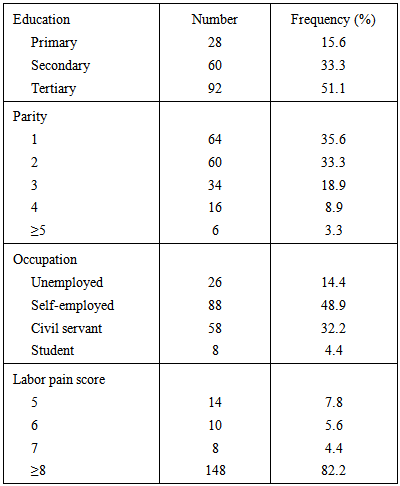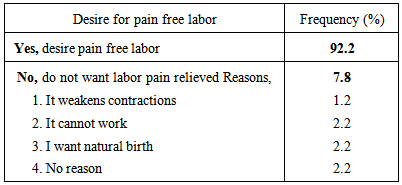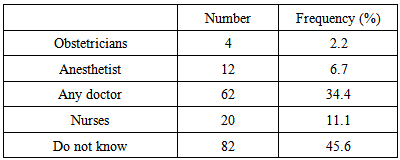-
Paper Information
- Paper Submission
-
Journal Information
- About This Journal
- Editorial Board
- Current Issue
- Archive
- Author Guidelines
- Contact Us
Research in Obstetrics and Gynecology
p-ISSN: 2326-120X e-ISSN: 2326-1218
2015; 3(2): 13-16
doi:10.5923/j.rog.20150302.01
Acceptability of Painless Labor among Pregnant Women in Owo, South-West Nigeria
Olorunfemi O. Owa1, 2, Folorunsho O. Alao3, Samuel O. Faturoti2, Babajide A. Temenu2, Steven A. Lemadoro2
1Department of Obstetrics and Gynaecology, Mother and Child Hospital Akure, Nigeria
2Department of Obstetrics and Gynaecology, Federal Medical Centre Owo, Nigeria
3Department of Anesthesia, Federal Medical Centre Owo, Nigeria
Correspondence to: Olorunfemi O. Owa, Department of Obstetrics and Gynaecology, Mother and Child Hospital Akure, Nigeria.
| Email: |  |
Copyright © 2015 Scientific & Academic Publishing. All Rights Reserved.
Background: Despite recent evolution of the fact that childbirth can be rendered painless, it is still not a generally embraced practice in the sub-Saharan Africa. Objectives: This study is aim at assessing the knowledge, desire and acceptability of a painless labor among pregnant women during antenatal and immediate postpartum women. Methods: This cross-sectional study of 180 women was conducted in the Department of Obstetrics and Gynaecology of a tertiary care hospital in Ondo State, South-West Nigeria from November 2013 to May 2014. Patients attending the antenatal clinics with previous labor experience and those in the lying-in ward of the hospital after delivery were interviewed with a semi-structured questionnaire after obtaining informed consent. The data obtained were analysed using SPSS 17. The results are presented in frequencies and percentages. Results: The mean age of the women was 30.9±4.5 years and all agreed that labor is painful. Only few of the women (32.2%) knew about pain free or pain relief in labor. Most women (92.2%) desired pain free or adequate analgesia in labor. Concerning knowledge of the women regarding labor pain relief methods, 46 (25.6%) were aware of injection, 4 (2.2%) said caesarean section is a method, 22(12.2%) were aware of epidural and 103 (60%) do not know any method. Of the few who will not want their labor pain relieved (7.8%), equal proportion of them will not without reason, that it won’t work or want natural labor. The average labor pain score on a numerical rating scale of 10 was 8.8±1.2. There were no significant associations between labor pain score or desire for painless labor with parity and the ante-natal or immediate postpartum women. Conclusions: Although many of the women were not aware that labor can be pain free, the overwhelming majority would want pain relief and even pain free labor. This should stimulate the accessibility of analgesia in labor in South West Nigeria and in the entire sub-Saharan Africa.
Keywords: Painless Labor, Obstetrics analgesia, Epidural, Desire for pain relief
Cite this paper: Olorunfemi O. Owa, Folorunsho O. Alao, Samuel O. Faturoti, Babajide A. Temenu, Steven A. Lemadoro, Acceptability of Painless Labor among Pregnant Women in Owo, South-West Nigeria, Research in Obstetrics and Gynecology, Vol. 3 No. 2, 2015, pp. 13-16. doi: 10.5923/j.rog.20150302.01.
1. Introduction
- Labor is a naturally painful experience; however the labor pain and delivery process varies among women [1]. Even for an individual woman, each child birth experience may be quite different. That labor is a painful process is not in contention [1-3]. A lack of knowledge regarding the birth process can influence a woman’s attitude to pain relief. Some women may understand the pain leading to birth, and view her pain as positive and as a good sign of progress [4]. A sense of accomplishment and enjoyment are sometimes experienced during labor and as a result, some women may refuse pain relief [5]. Other factors such as patient desire and choice of pain relief, labor support, risk level of clinical situation and provider influence can impact a woman’s pain experience. Pain relief in labor is an important issue in the management of pregnant women during childbirth. The reactions to labor pains vary with individuals and with each parous experience which could be shouting, crying, to the extent of irrational behaviors like suicidal attempt [4, 5]. The pain of labor is associated with reflex increases in blood pressure, oxygen consumption and liberation of catecholamines, all of which could adversely affect uterine blood flow [2]. Pain relief on the other hand could minimize these untoward effects [2]. The provision of pain relief in labor varies in different cultures, with some avoiding analgesia altogether while others do not want to feel pain at all in labor [6]. Studies have also shown that fewer women will want medical pain relief when interviewed during antenatal period but greater percentage will request for intrapartum pain relief [7-10]. The International Association for the Study of Pain (IASP) declared 2007 to 2008 the Global Year against Pain in Women, with the slogan “real women, real pain.” [11] There were three key points presented in the fact sheets published by IASP; the third key point is making labor pain as a clinical model for studying acute pain. Despite undeniable advances in our understanding of the physiology of labor pain that have resulted in the current safe and effective delivery of labor analgesia to the majority of women in the developed world, providing a “labor analgesia” often remains a significant challenge in labor rooms in Nigeria. Information about pain relief in labor is divergent with some of this information contradicting one another. However, for the subset of women who knew from the start that they want to deliver with minimal discomfort by means of an epidural, providing effective and safe labor analgesia is nowadays quite simple to achieve and most women in high-resource countries do choose to take advantage of modern state-of-the art obstetrical anesthesia and labor analgesia techniques [12]. The reality of labor pain comes as a shock to most women [12, 13]. Apart from information during previous delivery, the dominant source of information for women and their families has been shown to be nonmedical sources, by means of the media and the Internet [3, 4]. This study is aim at assessing the knowledge, desire and acceptability of a painless labor by pregnant and immediate postpartum women. It also seeks to compare the desire and acceptance of antenatal women with the immediate postpartum women and to evaluate the effect of the demographic variables on these parameters.
2. Methodology
- The study was conducted at Federal Medical Centre Owo over a period of 3months following approval from the hospital Ethics committee. The participants were selected using a purposive non-probability random sampling method among parturients who had previous labor pain experience. They were given a semi-structured questionnaire that assesses the knowledge, desire and acceptance of a painless labor after informed consent obtained. Labor pain score assessment using the numerical rating scale of 10 was done. The data obtained was subjected to statistical analysis using SPSS 17, expressed in form of tables and chart. Descriptive statistics using frequencies and percentages was also done. Chi-square was used to test for significance and a P < 0.05 considered statistically significant.
3. Results
- A total of one hundred and eight (180) women participated in this study, 120(66.7%) during the antenatal and 60(33.3%) at the immediate post-delivery periods. Out of total participants, 28 (15.6%) had primary education while 92 (51.1%) had tertiary education. The mean age of the studied population was 30.9 ± 4.5 years and parity ranges from one to six. (see table 1). The labor pain score on a numerical rating scale of 10 ranges from 5 – 10 with mean score of 8.8±1.2. Majority of the respondents (67.8%) are not aware that labor can be painless; however, almost all (92.2%) desire to have a pain free labor. Fourteen women will not want their labor pain relieved (7.8%) with reasons as depicted on Table-2. Table 3 showed who should provide pain relief in labor. Forty-six (25.6%) women had knowledge about injections, 4 (2.2%) women said elective caesarean section is the way to a pain free labor while 22 (12.2%) had knowledge about epidural analgesia but 103 (60%) do not know any method of pain relief in labor. There was a statistically significant association between the labor pain score and educational status (P < 0.050), previous anesthesia/surgery (P = 0.010) while parity (P = 0.70), whether antenatal or immediate postnatal (P = 0.970) did not significantly influenced the labor pain score. However, the desire for pain free labor is not associated with whether antenatal or immediate postnatal (P = 0.78), education (P = 0.35), parity (P = 0.15) and previous anesthesia/surgery depicted in Table 4.
|
|
|
|
4. Discussion
- Pain relief in labor is an important issue in the management of parturient in labor. This study showed that only few women were aware of the possibility of pain free labor. The knowledge about labor analgesia is still poor and similar to what was reported in Enugu [1], Ibadan [14] and Maduguri [2] Nigeria unlike in South Africa where more than half were aware [4]. The study showed a significant association between educational status and labor pain score, although some earlier studies [2, 6] has reported that there was no relationship between educational level and pain perception, however the small percentage (15.6%) of the participants having only primary education may have contributed to this findings. The study also showed a significant association between previous expose to anesthesia or surgery and labor pain score. However this association is not known to have been reported by any previous studies. Despite the poor knowledge of pain relief in labor, the overwhelming majority would want a pain free delivery. However, educational status, parity, previous anesthesia exposure, surgery, antenatal or immediate postpartum state was not significantly associated with the desire for a pain free labor. As regards knowledge of the participants on available labor pain relief methods, this study showed that while vast majority of the women (60%) do not know any method of pain relief in labor, only 12.2% were aware of epidural analgesia as a method. This is similar to the findings by Olayemi and colleague [14]. The awareness on the personnel involved in providing a pain free labor further buttress the ignorance as only 6.7% thinks it is the duty of the anesthetist. A particular question was asked if labor can be painless / pain free. The response showed that most of the women were not aware of the possibility of a labor without pain. Although only very few women will not want their labor pain relief if possible, the reason they gave include; weakens contractions, wanted natural birth, that it will not work and some for no reason. The obstetricians and in conjunction with the anesthetist can play an important role in disseminating appropriate and accurate knowledge regarding obstetrics analgesia and eliminating the fears and misconceptions of pregnant women thus making parturition a more interesting experience.
5. Conclusions
- This study showed poor general awareness of women about pain free labor, although majority desired to have a painless labor irrespective of whether pregnant or immediate postpartum women. It is recommended that information dissemination at the antenatal should comprise of adequate and appropriate information on labor analgesia. A collaborative approach between anesthetists and obstetricians to disseminate the appropriate knowledge regarding labor analgesia will be helpful and plans for anticipated pain free labor should be put in place so as to improve parturients satisfaction at child birth. Thus, this study should stimulate the accessibility of analgesia in labor in South West Nigeria and in the entire sub-Saharan Africa.
ACKNOWLEDGEMENTS
- Our gratitude goes to all the women who participated in the study, our midwives and resident doctor who also assisted in the data collection.
 Abstract
Abstract Reference
Reference Full-Text PDF
Full-Text PDF Full-text HTML
Full-text HTML


